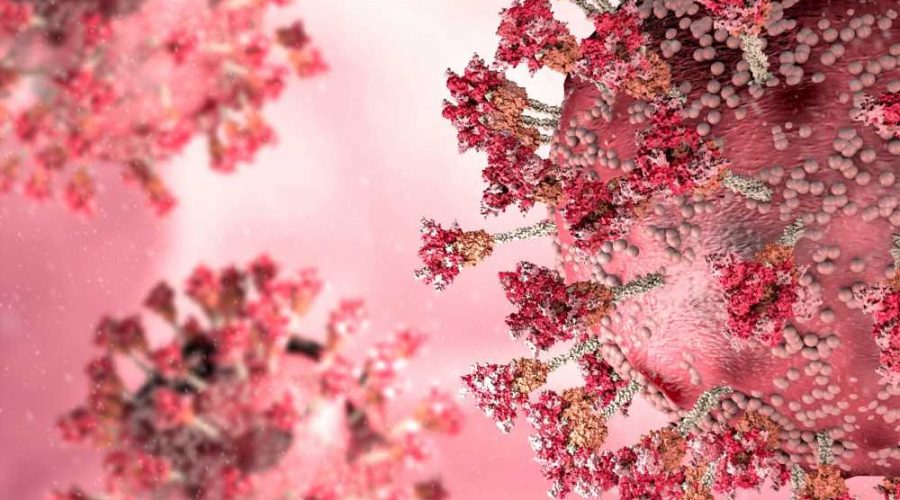Motif-based SARS-CoV-2 protein-human protein interactions as potential antiviral target sites
In a recent study posted to the bioRxiv* preprint server, researchers performed a ProP-PD (proteomic peptide phage display) analysis to identify peptides from intrinsically disordered human (host) proteome regions that bind with severe acute respiratory syndrome coronavirus 2 (SARS-CoV-2) genome-encoded folded protein domains (PDs).

Evers since the coronavirus disease 2019 (COVID-19) pandemic began, studies have been conducted to assess SARS-CoV-2 protein-host interactions by techniques such as mass spectroscopy (MS) and to identify potential antiviral agents. Drugs that could inhibit SARS-CoV-2 replication by targeting proteases and ribonucleic acid (RNA)-dependent-RNA polymerase or generate antibodies against the SARS-CoV-2 spike (S) protein could be used as antiviral agents; however, other SARS-CoV-2 proteins need to be explored to widen the therapeutic landscape of COVID-19.
About the study
In the present study, researchers investigated SARS-CoV-2-host protein-protein interactions of folded PDs encoded by the SARS-CoV-2 genome and SLiMs in the human proteome.
PD expression constructs (n=31) were created from SARS-CoV-2 proteins (n=22), of which 26 PDs were used for ProP-PD phage display selection screen analysis against the human disorderome (HD2) peptide library. The HD2 library displayed amino acid (aa) overlapping peptides (n=16) in the host proteome’s disordered sites on the M13 phage surface.
NGS (next-generation sequencing) analysis was performed to analyze binding-enriched phage pool peptide-coding sites, and fluorescence polarization (FP) analysis was performed to evaluate the binding affinities. To assess the peptide-non-structural protein 3 (Nsp3)-ubiquitin-like protein 1 (Ubl1) binding, an in-silico prediction analysis was performed.
Gene ontology (GO) terms enrichment analysis was performed, and = SLiM-based interactions were explored. ProP-PD analysis and alanine scanning SPOT arrays were performed to establish key specificity determinants. Nuclear magnetic resonance (NMR) analysis was performed to study peptide binding interfaces. The role of the identified protein-protein interactions in SARS-CoV-2 replication was investigated by conducting cell culture experiments using VeroE6 cells with 11 peptide ligands.
Results
Eleven folded PDs of the SARS-CoV-2 genome were bound to human genome peptides. Out of 281 high/medium (eight/273) peptides, 239 host proteins were found to interact with SARS-CoV-2 PDs (n=11) including Nsp1,3,5,8,9, and 16, Ubl1, adipocyte differentiation-related protein (ADRP), SUD-M, open reading frame (Orf)-8, 9b and nucleocapsid (N) protein N-terminal domain (NTD).
Drug Discovery eBook

Proteins and PDs successfully expressed in the study were Nsp1,4, 5, 7, 8, 9, 10,13, 15, 16, Ubl1,2, ADRP, SUD-N, M, C, papain-like protease (PLpro) and NGFI-A binding (NAB), of which, Nsp1,5, 8, 9, 16, Ubl1, ADRP, and SUD-M enriched ligands in ProP- PD selections. Most of the identified interactions involved Nsp9 (n=118), Nsp1 (n=47) and Nsp5 main protease (Mpro, n=32).
On the basis of the ProP-PD selection peptides, consensus motifs were established for the Nsp9 G[FL]xL[GDP] proteins and Nsp5 [FLM][HQ][AS]. For Mpro of Nsp5, the protein ligands could potentially serve as substrates since the identification motif resembled the protease’s preferred LQ↓[GAS] proteolytic site.
The FP analysis of 23 peptide-peptide interactions involving eight SARS-CoV-2 PDs showed binding affinities in the micromolar range. The leucine residues at P1 (position 1), with tyrosine residues at P5, were essential for binding, indicating that the Nsp3 Ubl1 binding motif in NCOA21074-1089 was LxxxY. Enrichment of ligands associated with transcriptional regulation processes was observed. Nsp3 SUD-M, Ubl1, and ADRP domains showed SLiM interacting capacity and 18 protein-protein interactions identified were per those reported in previous studies.
Key specificity determinants were established for six PDs, of which two and four were identified by ProP-PD and alanine scanning analyses, respectively. Of note, two peptides, targeting Nsp9 and Nsp16, inhibited SARS-CoV-2 replication. The team identified short peptide binders that interacted with Nsp9 through a GΦxΦ[GDP] motif, which also encompasses the GxxxG motif in the Nsp9 C-terminal region.
Several human proteins contain the motif, and interactions with Nsp9 could therefore impact SARS-CoV-2 replication. The NMR analysis showed that peptide binding perturbed Nsp9 hydrophobic core packing and consequently interfered with the formation of protein dimers. The peptide ligands were found to compete with Nsp10 for binding to Nsp16 and could therefore inhibit the Nsp10-Nsp16 interaction and prevent SARS-CoV-2 replication. Taken together, peptide ligands targeting ADRP, Nsp3, Nsp9 and Nsp16 inhibited SARS-CoV-2 proliferation and, therefore, could be potential drug development targets.
Overall, the study findings showed that ProP-PD screening is a viable strategy for identifying human peptides that bind to SARS-CoV-2 proteome globular domains. They also showed a subset of identified ligands could inhibit SARS-CoV-2 replication in cell culture, and the corresponding peptides could be developed as cell-penetrating anti-SARS-CoV-2 drugs. The study findings expand the peptide repertoire that may be considered a starting point for SARS-CoV-2-targeted drug discovery.
*Important notice
bioRxiv publishes preliminary scientific reports that are not peer-reviewed and, therefore, should not be regarded as conclusive, guide clinical practice/health-related behavior, or treated as established information.
- Filip Mihalic et al. (2022). Identification of motif-based interactions between SARS-CoV-2 protein domains and human peptide ligands pinpoint antiviral targets. bioRxiv. doi: https://doi.org/10.1101/2022.10.07.511324 https://www.biorxiv.org/content/10.1101/2022.10.07.511324v1
Posted in: Medical Science News | Medical Research News | Disease/Infection News
Tags: Alanine, Amino Acid, Antibodies, Cell, Cell Culture, Coronavirus, Coronavirus Disease COVID-19, covid-19, Drug Discovery, Drugs, Fluorescence, Gene, Genome, Leucine, Pandemic, Peptides, Polymerase, Proliferation, Protein, Proteome, Respiratory, Ribonucleic Acid, RNA, SARS, SARS-CoV-2, Severe Acute Respiratory, Severe Acute Respiratory Syndrome, Spectroscopy, Structural Protein, Syndrome, Tyrosine, Ubiquitin

Written by
Pooja Toshniwal Paharia
Dr. based clinical-radiological diagnosis and management of oral lesions and conditions and associated maxillofacial disorders.
Source: Read Full Article
